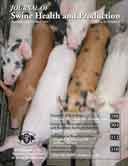Abstract:

Effect of group size-floor space allowance and floor type on growth performance and carcass characteristics of heavy pigs
R. Rossi, MSc, PhD; A. Costa, MSc, PhD; M. Guarino, MSc, PhD; F. Laicini, MSc; G. Pastorelli, MSc, PhD; C. Corino, MSc
PDF version is available online.
Objective: To evaluate the effects of group size-space allowance and floor type on growth performance and carcass characteristics in pigs slaughtered at 160 kg live weight (LW).
Materials and methods: (Landrace × Large White) × Duroc pigs (N = 216), averaging 89.8 ± 0.4 kg LW at approximately 6 months of age, were evenly distributed among 18 pens (six pens per room, equal numbers of barrows and gilts per pen). Nine pens provided a low space allowance (LSA; k = 0.033; 1.0 m2 per animal; 126 pigs), and nine pens provided a high space allowance (HSA; k = 0.047; 1.4 m2 per animal; 90 pigs). After 90 days, six pigs per pen were slaughtered (total 108 pigs; 156 ± 1.4 kg LW). The proportion of floor contaminated with manure, urine, or both, and environmental parameters, were recorded during the observation period.
Results: Pigs on all floor types tended to gain more weight with HSA than with LSA (P = .08) days 46 to 90. Average daily gain (ADG) and final LW were higher for barrows than gilts (P < .05). Feed conversion ratio tended to be lower (P < .10) for HSA than LSA animals. Backfat thickness was higher for HSA and rooms with totally slatted floors. Contaminated floor area was smaller with totally slatted floors.
Implications: Increasing space allowance from k = 0.033 to k = 0.047 is associated with better ADG at LW > 120 kg, suggesting that this change might be of benefit to the heavy-pig industry.
Keywords: performance, carcass, housing, space allowance
![]() Cite as: Rossi R, Costa A, Guarino M, et al. Effect of group size-floor space allowance and floor type on growth performance and carcass characteristics of heavy pigs. J Swine Health Prod 2008;16(6):304-311.
Cite as: Rossi R, Costa A, Guarino M, et al. Effect of group size-floor space allowance and floor type on growth performance and carcass characteristics of heavy pigs. J Swine Health Prod 2008;16(6):304-311.
Search the AASV web site for pages with similar keywords.
